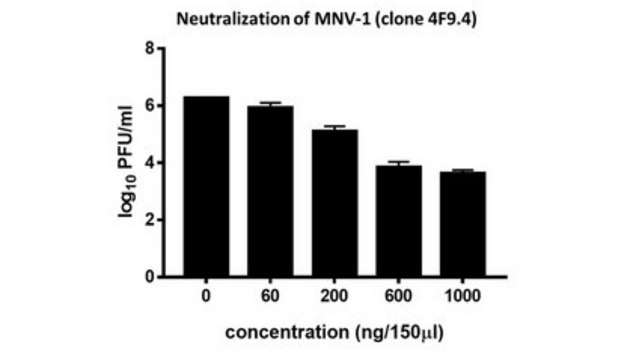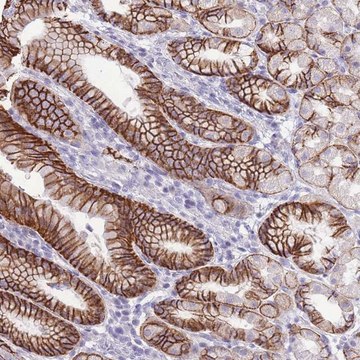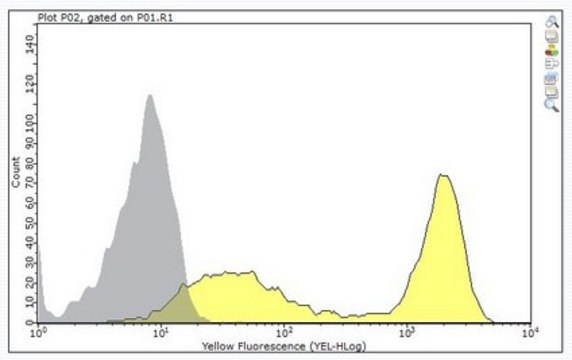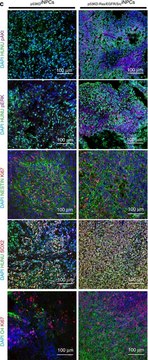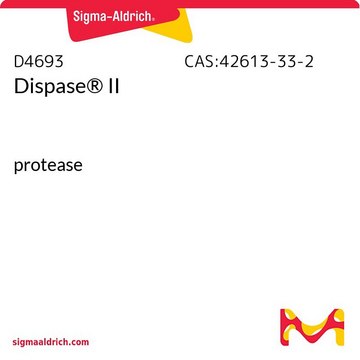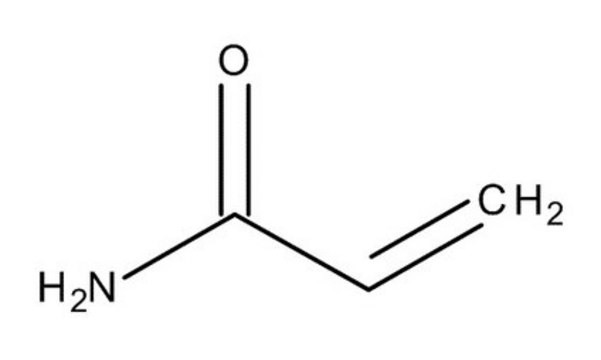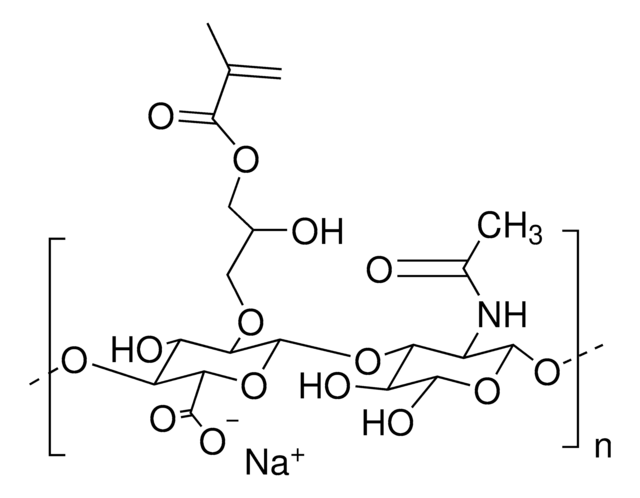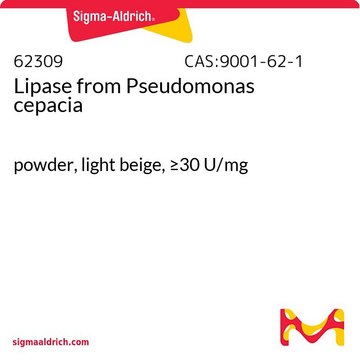MABF2097
Anti-Norovirus (MNV-1) Antibody, clone 5C4.10
clone 5C4.10, from mouse
Synonym(s):
MNV-1, Murine Norovirus
Sign Into View Organizational & Contract Pricing
All Photos(1)
About This Item
UNSPSC Code:
12352203
eCl@ss:
32160702
NACRES:
NA.41
Recommended Products
biological source
mouse
antibody form
purified immunoglobulin
antibody product type
primary antibodies
clone
5C4.10, monoclonal
species reactivity
virus, norovirus
packaging
antibody small pack of 25 μg
technique(s)
ELISA: suitable
western blot: suitable
isotype
IgG2bκ
target post-translational modification
unmodified
General description
Norovirus is a member of the Caliciviridae family and is responsible for gastroenteritis outbreaks. Murine norovirus (MNV-1) that is about 28 to 35 nm in diameter, shares many biochemical and genetic features with human noroviruses. An analysis of the MNV-1 genome shows three open reading frames (ORF) that are characteristic of noroviruses and vesiviruses. ORF1 is reported to encode a predicted 187 kDa polyprotein that contains the 2C helicase, 3C protease, and 3D polymerase motifs. ORF2 encodes a 59 kDa capsid protein that can self-assemble into virus-like particles when expressed in a baculovirus expression system. ORF3 is reported to encode a putative 22 kDa basic protein. The norovirus capsid protein contains a highly conserved shell (S) and protruding (P) domain and the P domain is shown to contain binding sites for receptors and neutralizing antibodies. The S domain is shown to be highly conserved and the capsid sequence diversity is limited to the P domain. MNV-1 infection is reported to modulate the MAPK pathway to activate eIF4E phosphorylation and the activation of p38 and Mnk during MNV-1 infection is considered to be important for its replication. This monoclonal antibody, clone 5C4.10, recognizes the S domain portion of the viral capsid protein and is broadly reactive with pan-noroviruses of murine and human type. (Ref.: Kolawole AO, et al. (2017). mSphere 2: e00334-17; Kolawole, AO et al. (2014). J. Gen. Virol. 95(9); , 1958 1968; Royall, E., et al. (2015). J. Biol. Chem. 290(8); 4748-58; Wobus, CE et al. (2006). J. Virol. 80(11); 5104-5112).
Specificity
Clone 5C4.10 specifically recognizes the S domain portion of capsid protein of murine Norovisrus.
Immunogen
Infectious and UV-inactivated murine norovirus-1.
Application
Anti-Norovirus (MNV-1), clone 5C4.10, Cat. No. MABF2097, is a mouse monoclonal antibody that detects murine Norovirus capsid protein and has been tested for use in ELISA and Western Blotting.
Research Category
Inflammation & Immunology
Inflammation & Immunology
Western Blotting Analysis: A representative lot detected Norovirus (MNV-1) in Western Blotting applications (Kolawole, A.O., et. al. (2014). J Gen Virol. 95(Pt 9):1958-68).
ELISA Analysis: A representative lot detected Norovirus (MNV-1) in ELISA applications (Kolawole, A.O., et. al. (2014). J Gen Virol. 95(Pt 9):1958-68; Kolawole, A.O., et. al. (2017). mSphere. 2(5). pii: e00334-17).
ELISA Analysis: A representative lot detected Norovirus (MNV-1) in ELISA applications (Kolawole, A.O., et. al. (2014). J Gen Virol. 95(Pt 9):1958-68; Kolawole, A.O., et. al. (2017). mSphere. 2(5). pii: e00334-17).
Quality
Evaluated by Western Blotting in RAW 264.7 cells infected with Murine norovirus-1.CW3.
Western Blotting Analysis: 1 µg/mL of this antibody detected Norovirus (MNV-1) in RAW 264.7 cells infected with Murine norovirus-1.CW3.
Western Blotting Analysis: 1 µg/mL of this antibody detected Norovirus (MNV-1) in RAW 264.7 cells infected with Murine norovirus-1.CW3.
Target description
~57 kDa observed. Uncharacterized bands may be observed in some lysate(s).
Physical form
Format: Purified
Protein G purified
Purified mouse monoclonal antibody IgG2b in buffer containing 0.1 M Tris-Glycine (pH 7.4), 150 mM NaCl with 0.05% sodium azide.
Storage and Stability
Stable for 1 year at 2-8°C from date of receipt.
Other Notes
Concentration: Please refer to lot specific datasheet.
Disclaimer
Unless otherwise stated in our catalog or other company documentation accompanying the product(s), our products are intended for research use only and are not to be used for any other purpose, which includes but is not limited to, unauthorized commercial uses, in vitro diagnostic uses, ex vivo or in vivo therapeutic uses or any type of consumption or application to humans or animals.
Not finding the right product?
Try our Product Selector Tool.
Regulatory Information
新产品
Certificates of Analysis (COA)
Search for Certificates of Analysis (COA) by entering the products Lot/Batch Number. Lot and Batch Numbers can be found on a product’s label following the words ‘Lot’ or ‘Batch’.
Already Own This Product?
Find documentation for the products that you have recently purchased in the Document Library.
Jake T Mills et al.
Journal of virology, 97(12), e0171923-e0171923 (2023-11-30)
All viruses initiate infection by utilizing receptors to attach to target host cells. These virus-receptor interactions can therefore dictate viral replication and pathogenesis. Understanding the nature of virus-receptor interactions could also be important for the development of novel therapies. Noroviruses
Yifan Zhu et al.
Molecules (Basel, Switzerland), 25(18) (2020-09-11)
In this study, we investigated the impact of GD1a-expressing bacterial strains on the infectivity of murine norovirus (MNV). Eligible bacterial strains were screened from a sewage sample using flow cytometry, and their genetic sequences of 16S rRNA were determined. The
Alberto A Amarilla et al.
Nature communications, 12(1), 3431-3431 (2021-06-10)
The current COVID-19 pandemic is caused by the severe acute respiratory syndrome coronavirus 2 (SARS-CoV-2). We demonstrate that despite the large size of the viral RNA genome (~30 kb), infectious full-length cDNA is readily assembled in vitro by a circular polymerase
Yohei Takeda et al.
Viruses, 12(7) (2020-07-02)
Novel severe acute respiratory syndrome coronavirus 2 (SARS-CoV-2), influenza A virus (IAV), and norovirus (NV) are highly contagious pathogens that threaten human health. Here we focused on the antiviral potential of the medicinal herb, Saxifraga spinulosa (SS). Water-soluble extracts of
Lingling Liu et al.
Foods (Basel, Switzerland), 9(3) (2020-03-14)
As the leading cause of acute gastroenteritis worldwide, human noroviruses (HuNoVs) have caused around 685 million cases of infection and nearly $60 billion in losses every year. Despite their highly contagious nature, an effective vaccine for HuNoVs has yet to
Our team of scientists has experience in all areas of research including Life Science, Material Science, Chemical Synthesis, Chromatography, Analytical and many others.
Contact Technical Service